 Research Article
Research Article
Small-Scale Metastability in a Coastal Ecosystem of The Baltic Sea
Henrik Skov, DHI, Agern Alle 5, DK-2920, Denmark
Received Date: September 2, 2021; Published Date: September 22, 2021
Abstract
A high-resolution ecosystem model of the Gulf of Riga was used to describe gradients and small-scale persistence of patches of two bivalve species (Macoma Baltica and Mytilus edulis) between 1970 and 2003. Weekly estimates of biomass estimates (g DW soft tissue/m2) were extracted from the model output, and long-term trends in spatial structure were analyzed on biomasses at a scale of 5 km. The distribution of the modelled biomass was extremely patchy for both species. High levels of patchiness were superimposed on seasonal trends. Yet, despite the patchiness, the spatial gradients in the biomass showed remarkable stability and persistence over the studied 34 years, and the mean distributions of biomasses were highly correlated between decades (r 0.972-0.979 for Mytilus and 0.812-0.982 for Macoma). The results highlight the challenges using largescale ecosystem model results to describe spatial gradients and patchiness in benthic productivity found in coastal ecosystems. The spatial structure of the modelled biomass of both species clearly indicates the occurrence of pervasive patchiness and strong persistence in spatial patterns of distribution. The spatial stability of distribution patterns has important implications for the requirements for high-resolution model data needed to establish the status and trends of benthic habitats in coastal ecosystems.
Keywords: Food web models; Coastal ecosystems; Long-term trends; Baltic Sea; Bivalves; Mytilus edulis; Macoma baltica
Introduction
Due to the paucity of detailed monitoring data from many coastal areas, food web or ecosystem models like Ecosim/Ecopath [1,2] have often been applied in assessments of ecosystem impacts of human activities. With the use of data-driven models relying on large pre-existing datasets new insights on complex or underlying phenomena driving many marine and coastal ecosystems, including those in the Baltic Sea have evolved. Yet, with a spatial resolution, which is obviously larger than the scale of patchiness found in benthic invertebrate populations [3,4] large-scale ecosystem models have often been constrained by the assumption that patchiness is random or stochastic within large-scale homogenous units.
In landscape ecology, the term metastability or conditional stability has been introduced to describe the state of stability of spatially variable landscape elements, whose geographical characteristics are predictable for specific climatic scenarios [5,6]. Waide JB, et al. [6] argued that ecosystem stability implies dynamic stability, and that statements about ecosystem stability are often biased by human perception of rates of change in nature leading to an improper hierarchy of different environments in relation to their apparent constancy of function over time. Obviously, the biomass and productivity of coastal invertebrate populations changes with season and between years. Instability in the distribution of these populations would be characterized by systematic changes in the variance pattern, e.g. in a transient state caused by climatic changes or invasive species. However, following the notion of Waide, distributions of marine fauna exhibiting predictable variance patterns like biomasses of benthic invertebrates may be judged conditionally stable in relation to a particular physiochemical environment.
In order to assess the persistence and metastability of smallscale patchiness in the distribution of benthic invertebrate biomasses in coastal areas of the Baltic Sea we applied a downscaled ecosystem model developed for the Gulf of Riga and Irbe Strait for the years 1970-2003. The model has been developed and calibrated to quantify growth of populations of two bivalve species (Macoma Baltica and Mytilus edulis) which both display high levels of patchiness superimposed on seasonal trends and potentially long-term trends. By establishing the occurrence of metastability in the spatial structure of these two invertebrate species we hoped to throw new light on the potential (methodological) challenges to describe gradients and patchiness in benthic productivity found in these areas, and ultimately to provide unbiased estimates of the status of benthic populations.
Materials and Methods
Study region
The study region was the Gulf of Riga in the north-eastern part of the Baltic Sea and Irbe Strait, which is the main connection between the Gulf of Riga and the Baltic Sea (Figure 1). The Gulf of Riga is shallow, with a maximum depth of 60m. The drainage area of the basin is about ten times larger than the surface area of the Gulf. Five relatively large rivers discharge their waters to the Gulf. The salinity regime of the Gulf of Riga is characterized by a lack of a halocline and high spatio-temporal variability from 0.5-2.0 PSU in spring in the surface layers, and up to 7.5-7.7 PSU at the bottom of the Irbe Strait in spring and summer [7]. The relatively low salinity of the Gulf of Riga is the result of isolation of the basin from the more saline waters in the deeper part of the Baltic proper and high freshwater inflow. During the summer season, a strong thermocline separates the upper (> 15 °C) and deeper (< 6 °C) water layers. Surface water (0-10 m) temperature exceeds 10 °C from the third week of May until the end of September. Long-term mean ice cover duration in the north-eastern Gulf of Riga is 132 days [7]. The bottom of the Gulf of Riga is very diverse in structure and origin. The prevailing seabed type is an accumulation bottom. The coastline of the Gulf is mostly open and exposed in the eastern part while a system of shallow, enclosed bays with soft accumulation bottoms occurs in the northern part.
Ecosystem model
We applied a coupled local hydrodynamic and ecosystem model (MIKE 3 FM and ECOLAB) which has been run in hind-cast for a period of 34 years (1970-2003) and provides weekly estimates of the biomass of mussels and clams. The hydrodynamic and water quality components of the model complex have been set up with forcing from regional meteorological and hydrodynamic models and calibrated with regional and local run offs, nutrient concentrations and biological data. The ecosystem model describes concentrations and processes related to phytoplankton, zooplankton, nutrients, dead organic matter (detritus), and dissolved oxygen. Furthermore, advanced descriptions of the benthic vegetation community and growth of mussel and clam populations were developed https:// www.mikepoweredbydhi.com/products/eco-lab,including detailed descriptions of their growth and death processes, as well as modelling of the specific dependencies for flow velocities, phytoplankton, nutrients, temperature and light. A detailed description of the setup of the Gulf of Riga ecosystem model was provided by [8,9].
Statistical analysis
In order to use the modelled time series in statistical analyses the weekly estimates of biomass (g DW soft tissue/m2) of Mytilus edulis and Macoma baltica were exported from MIKE unstructured mesh (dfsu) files to 5 km gridded NetCDF files, which could be imported into statistical software.
The spatial stability of the biomasses of bivalves was analyzed by determining changes in patches of higher biomass and correlating modelled mean distributions over each of the following three periods: 1970-1980, 1981-1990 and 1991-2003. Correlations between mean distributions were made using Pearson correlations, while patches of higher biomass of bivalves were determined using the 90th percentile of the mean biomass distribution. The 90th percentile was chosen due to the robustness and transparency of this method, and as it is widely established as a useful upper threshold.
Results
Both local Macoma and Mytilus biomasses were mainly distributed within the parts of the Gulf of Riga and Irbe Strait with depths less than 20m, and both species displayed high levels of patchiness superimposed on seasonal trends. Spatial gradients in modelled biomass were in the order of 10x and seasonal trends were typically in the order of 3-4x background levels of biomass (Figures 2,3). The distribution of the modelled biomass was extremely patchy for both species. Yet, despite the patchiness, the spatial gradients in the biomass showed remarkable stability and persistence over the 34 years. Patches for Mytilus defined by the 90 percentiles of the modelled mean biomass over each decade covered only between 5.9% and 6.2% of the model area (Table 1) and the spatial distributions of Mytilus mean biomasses were highly correlated between decennia (r 0.972-0.979, Pearson, Figure 4). For Macoma patches covered between 8.2% and 8.9% of the model area (Table 1) and the spatial distributions of Macoma mean biomasses were also highly correlated between decennia (r 0.812- 0.982, Pearson, Figure 5).
Table 1:Proportion (%) of model area in the Gulf of Riga/Irbe Strait defined by the 90 percentile of the mean biomass distribution of Mytilus edulis and Macoma Baltica in the Gulf of Riga during 1970-1980, 1981-1990 and 1991-2003.

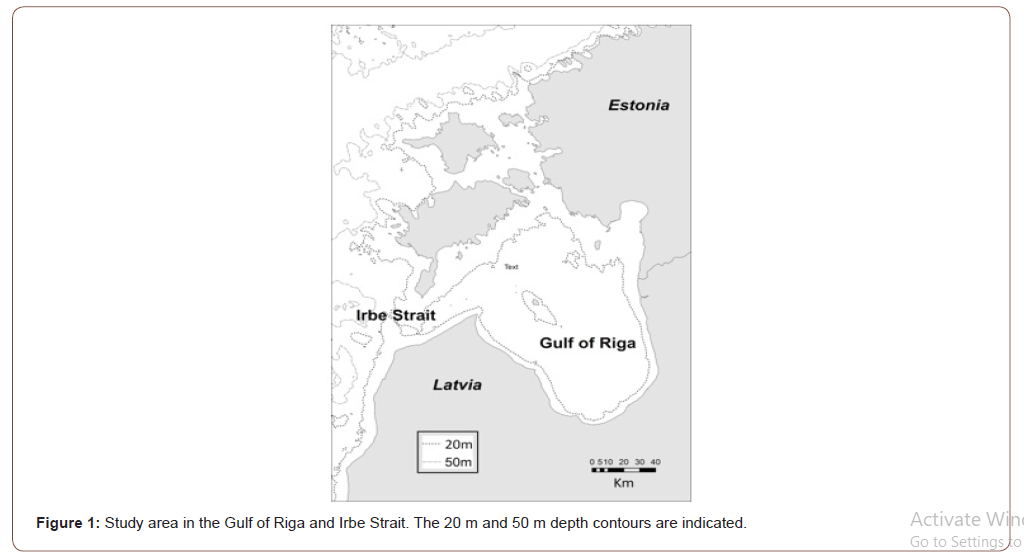

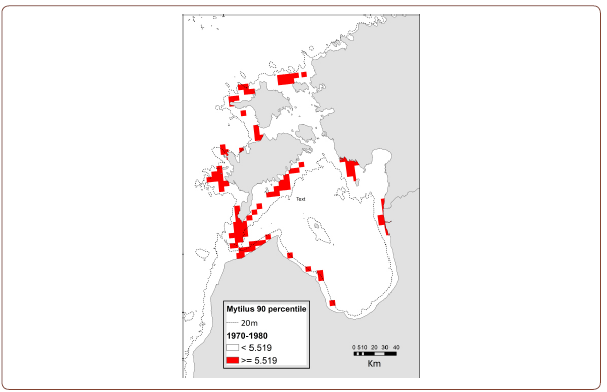
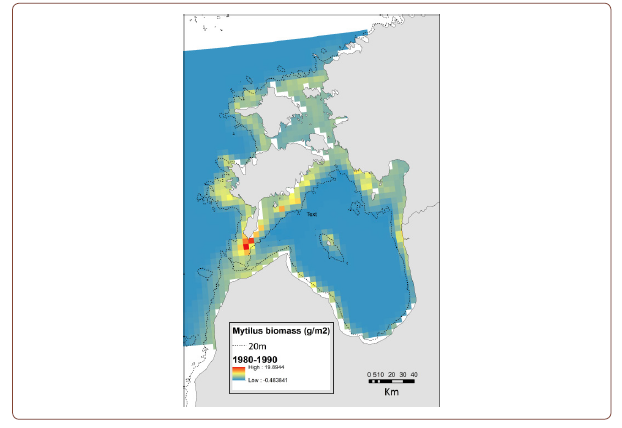
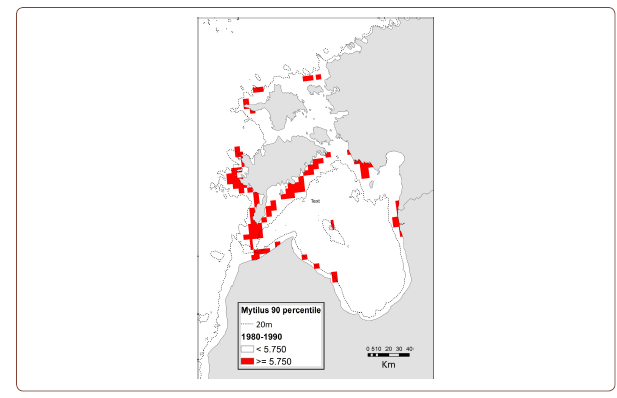
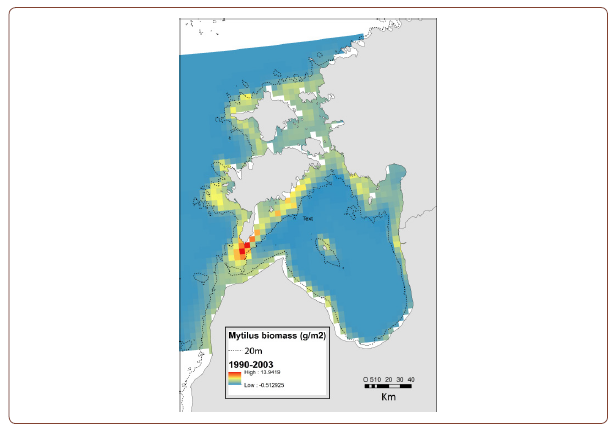
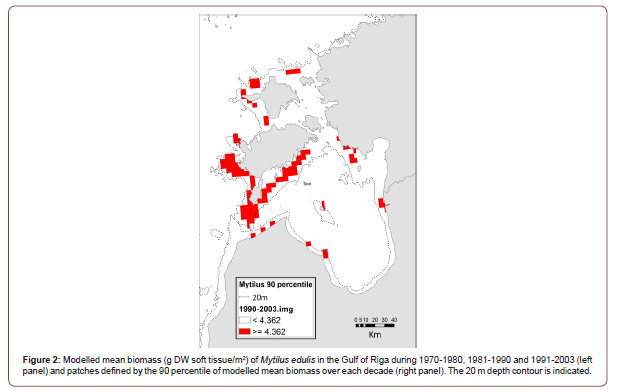
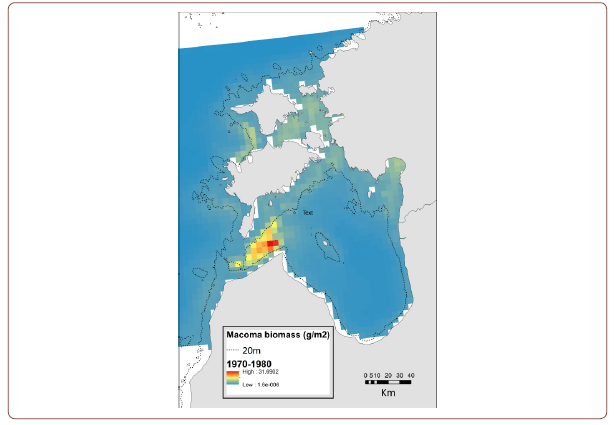
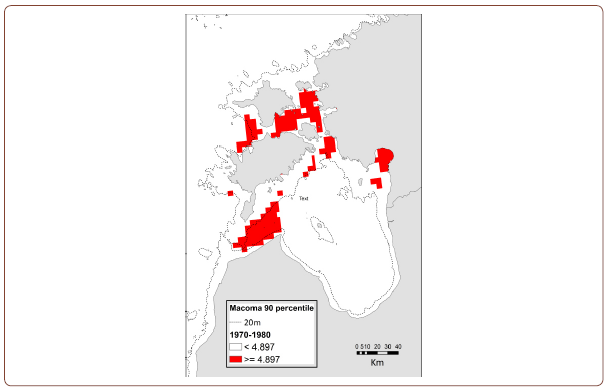
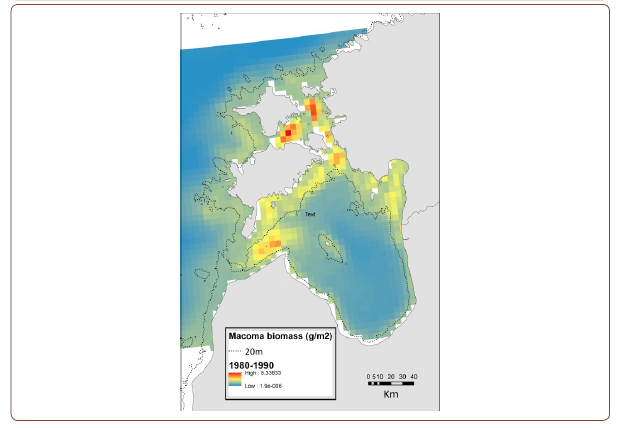
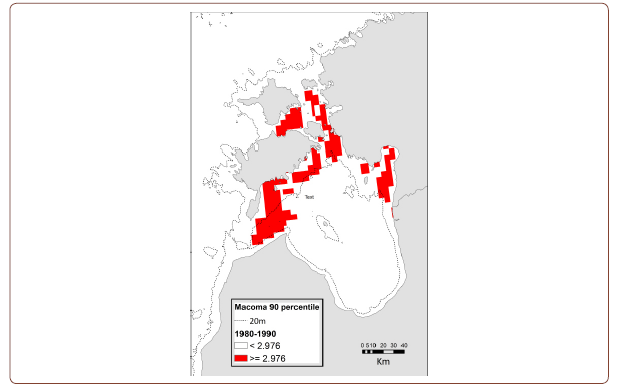

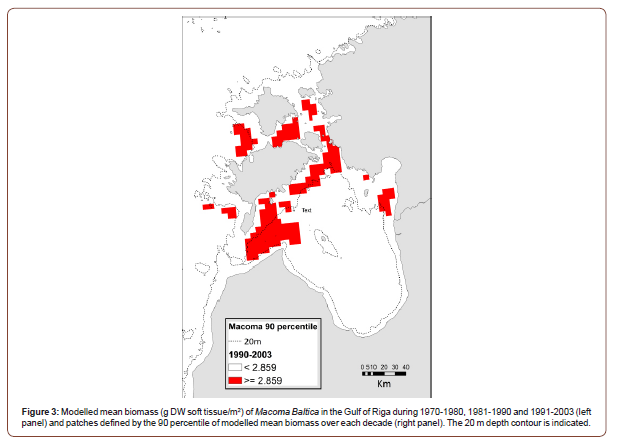
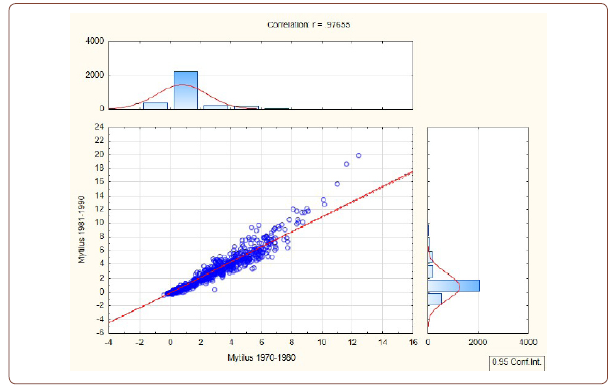
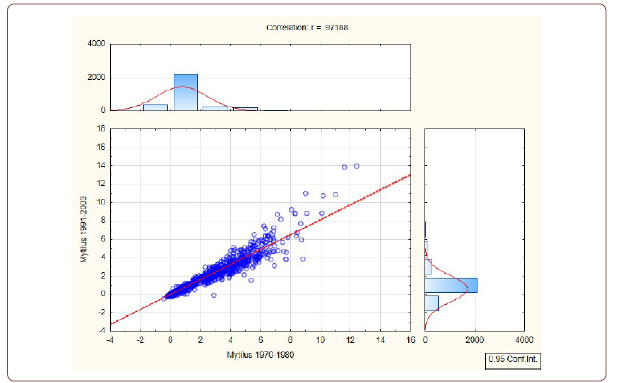
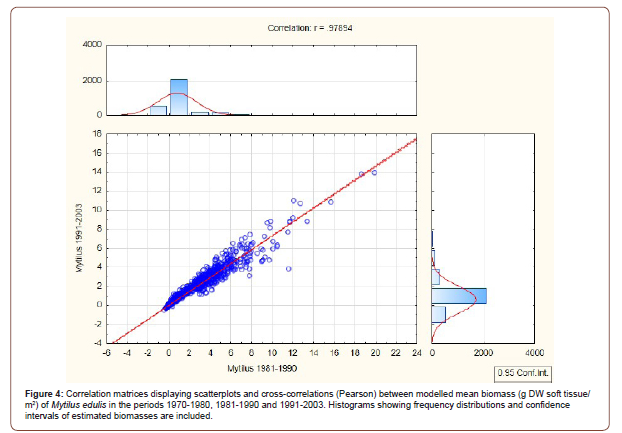
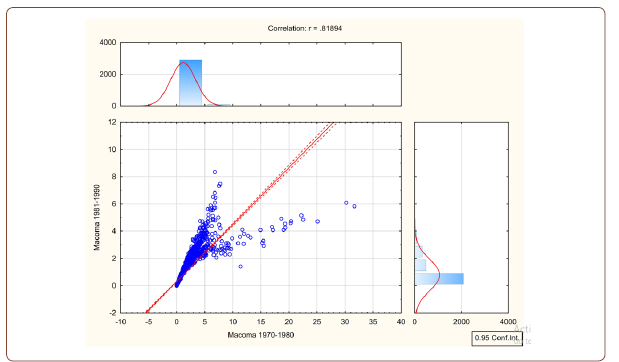


Discussion and Conclusion
Our model study in the Gulf of Riga and Irbe Strait provided strong indications of persistent small-scale patchiness in the distribution of benthic invertebrate biomasses (bivalves) in coastal areas of the Baltic Sea. Several processes drive the dispersal, settling and growth of bivalves, and although the Gulf of Riga ecosystem model has been designed to accommodate quantitative descriptions of rates of transfer through detritus and plankton to bivalves at a relatively high resolution the model complex does represent a simplification of the local benthic ecosystem. Both intraspecific and inter-specific interactions and predation, e.g. from invasive species, have been quantified without spatial details due to the absence of local calibration data, which may have introduced less variability in growth patterns of bivalves between years than observable in the field [8].
Thus, the model provided us with a unique opportunity to study the spatial variability of the productivity of invertebrates as driven by the local geography of hydrodynamics in the Gulf of Riga. The observed metastability and extreme patchiness reflect the stability of the flow patterns and advection processes in the Gulf, - a stability which may not be atypical in coastal environments with heterogeneous but persistent hydrodynamics. The fine-scale dispersal of Mytilus in the Gulf of Riga was studied by [10], who reported both recurring patterns but also prominent year-to-year variations in the settling of larvae. The density and condition of adult Mytilus is mainly related to the availability of hard substrate and food supply in terms of the flux of phytoplankton (phytoplankton concentration x current speed), which in turn is regulated by light, temperature and nutrient availability. A low level or predictable variance pattern in these factors is most likely to constitute the main driver behind the modelled metastability.
If the existence of persistent metastability in the distribution of patches in the biomasses of invertebrates over long periods of time is ignored in ecosystem modelling then estimates of rates of interaction between ecosystem compartments may be erroneous [11]. As these rates form the basis for determining growth and mortality rates in most modelled compartments these rates control a large part of the model dynamics. Accordingly, coarsescale ecosystem models may not only result in biased estimates for the biomasses of invertebrates in question but may also produce biased estimates for other model compartments like predators. In assessments of ecosystem impacts of human activities these potential biases could have important consequences for the credibility of assessments in many coastal regions, i.e. models will tend to overestimate impacts outside patches (type II error) and underestimate impacts inside patches (type I error).
If persistent patchiness of benthic invertebrate populations is a widespread phenomenon in coastal environments this could have a significant effect on the distribution and movement of benthivorous predators. Skov H, [12] studied decadal changes in the distribution of molluscuvorous waterbirds wintering in the Baltic Sea and found evidence of persistent distribution patterns over the period from 1985 to 2010. This was the case even though several populations of waterbirds have suffered declines in the Baltic Sea of more than 50% during this period. Obviously, metastability in coastal benthic ecosystems might be equally reflected by predator populations, - an observation which may have consequences for the strategies for designation of marine protected areas.
The habitat sub-type Biogenic reefs listed under Reefs in the Annex I of the EU Habitat Directive includes concretions made by marine invertebrates arising from the surrounding seafloor [13]. The designation of SACs (EU Special Areas of Conservation) for this habitat sub-type could benefit from results of fine-scale ecosystem models like the one developed for the Gulf of Riga by capitalizing on the estimates of persistent patches of high densities of mussels, which may provide efficient guidelines for focusing mapping efforts.
Acknowledgment
Anne Lise Middelboe is thanked for reviewing an early version of the draft. Calibration observations were received from Jonne Kotta, Estonian Marine Institute. The modelling work is based on the BONUS BIO-C3 project and has received funding from BONUS, the joint Baltic Sea research and development program (Art 185), funded jointly from the European Union’s Seventh Program for research, technological development and demonstration and from the Danish and Estonian Research Council. In addition, the work has been supported by Institutional research funding IUT02-20 of the Estonian Research Council.
Conflict of Interest
No conflict of interest.
References
- Pauly D, Christensen V, Walters C (2000) Ecopath, Ecosim, and Ecospace as tools for evaluating ecosystem impact of fisheries. ICES J Mar Sci 57(3): 697-706.
- Christensen V, Walters C, Pauly D, Forrest R (2008) Ecopath with Ecosim Version 6: User Guide. Lenfest Ocean Futures Project.
- Caddy JF (1975) Spatial model for an exploited shellfish population, and its application to the Georges Bank scallop fishery. Journal of the Fisheries Research Board of Canada 32(8): 1305-1328.
- Orensanz JM, Jamieson GS (1998) The assessment and management of spatially structured stocks: an overview of the North Pacific Symposium on Invertebrate Stock Assessment and Management. In: Jamieson GS, Campbell A (edts), Proceedings of the North Pacific Symposium on Invertebrate Stock Assessment and Management. Can Spec Publ Fish Aquat Sci. 125: 441–459.
- Forman RTT, Godron M (1986) Landscape Ecology. John Wiley & Sons. New York, USA.
- Waide JB (1995) Forest ecosystem stability: Revision of the resistance-resilience model, edited by Patten, BC & Jørgensen, SE Prentice Hall Ptr. New Jersey, USA, pp. 372-396.
- Ojaveer E (1995) Large-scale processes in the ecosystem of the Gulf of Riga. In: Ojaveer, E. (edt), Ecosystem of the Gulf of Riga between 1920 and 1990. Estonian Academy, Tallinn: pp. 268-277.
- Rasmussen EK, Zydelis R, Uhrenholdt T, Middelboe A (2015) The bottom to top consumer modelling complex. In: Report on effects of changing drivers on pelagic and benthic species composition and production, edited by Winder, M. Deliverable 2.1 from Bonus-BIO-C3.
- Skov H, Rasmussen EK, Kotta J, Middelboe AL, Uhrenholdt T and Žydelis R (2020) Food web responses to eutrophication control in a coastal area of the Baltic Sea. Ecological Modelling 435: 109249.
- Middelboe AL, Potthoff M, Closter RM, Møhlenberg F, Jonsson P (2016) Fine-resolution modelling of connectivity between Mytilus populations in the Gulf of Riga area, Baltic Sea. Input to BIO-C3 WP 3.3 Report. Thünen Institute of Baltic Sea Fisheries.
- Spigarelli SA, Thommes MM (1979) Temperature selection and estimated thermal acclimation by rainbow trout (Salmo gairdneri) in a thermal plume. Journal of the Fisheries Research Board of Canada 36: 366-376.
- Skov H (2014) Decadal changes in the boundaries of concentrations of marine birds – consequences for marine protected areas. Proceedings Littoral 2014: 22-26.
- EU Habitats Directive (1992) Council Directive 92/43/EEC of 21 May 1992 on the conservation of natural habitats and of wild fauna and flora. Official Journal of the European Communities No. L206: 22-07-1992.
-
Henrik Skov, Erik Kock Rasmussen. Small-Scale Metastability in a Coastal Ecosystem of The Baltic Sea. Ad Oceanogr & Marine Biol. 3(1): 2021. AOMB.
-
Food web models, Coastal ecosystems, Long-term trends, Baltic Sea, Bivalves, Mytilus edulis, Macoma baltica
-

This work is licensed under a Creative Commons Attribution-NonCommercial 4.0 International License.






